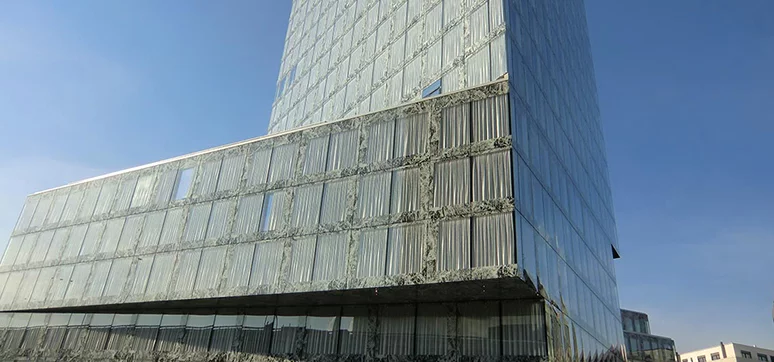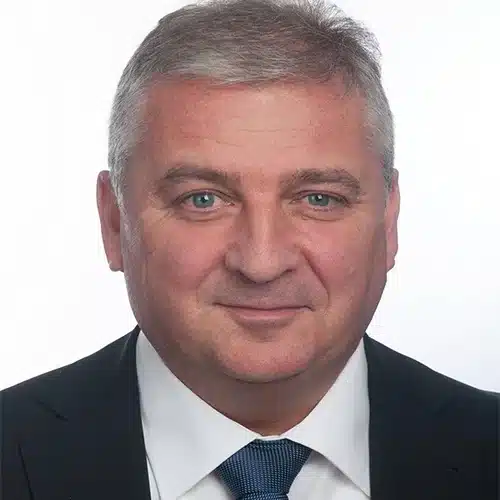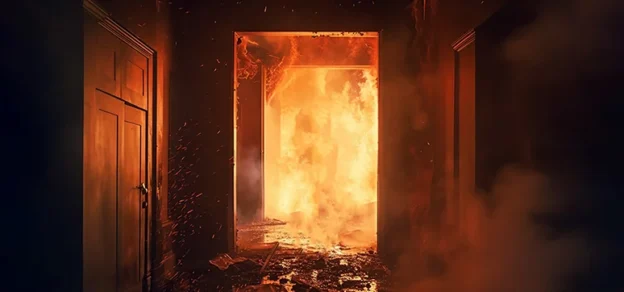Numerous innovations have been seen in the last decades concerning new façade technologies. These were driven by new materials or new applications of known materials, such as glued-on wall structures (structural glazing) in the ’60s and ’70s. On the other hand, we saw the increasing introduction of double and multiple-layer façades including a return to natural ventilation in the ’90s and the new millennium.
Today we see the closed cavity façade (CCF) as a promising and innovative way to develop new possibilities, especially for high-rise buildings that may come to the same rank within the next years. The following report will provide an overview of the existing systems. It will also point out the challenges and the chances of this advanced new façade system. Furthermore, several reference projects of the past years are presented, both completed and under construction. The report shows the way to functional proper design and it illustrates the most important issues of good quality assurance management.
From Double Skin Facade To Closed Cavity Facade

A number of positive examples of double-skin facade buildings have been reported. In case an open competition for the erection took place, prices were often more moderate than expected. Books were published at the turn of the millennium, on how the engineering of façade and ventilation may be optimised. Nevertheless, the examples with limited function, heat-up or short-circuiting from exhaust to supply air exist in large numbers as well. Especially if openings to the outside or distances between inner and outer skin are reduced too much, such faults appear.
This insight created a new idea for a double-skin façade type called closed cavity facade abbreviated as “CCF”. The combination of the advantages of a single-skin façade with those of a double-skin facade led to a non-ventilated double skin with very good heat insulation to the inside and a larger depth to the outside.
The Advanced Facade Technology – CCF
Quick Facts:
Project: Power Tower Linz
Client: Energie AG Upper Austria / A-Linz Architect Planning
Design: Weber & Hofer AG / CH-Zurich
Architect Design: Prof. Kaufmann & Partner / A-Linz
Façade builder: GIG GmbH / A-Puchheim

The façade type closed cavity facade (CCF) avoids the pollution of its inside surfaces as it is not exposed to ventilation. Condensation is suppressed with the supply of dried air to the inside, but the amount is very low, as the unit is constructed to be almost airtight. The good sound insulation and sun shading properties of a double-skin facade are maintained. If one needs a possibility for natural ventilation, an openable flap can be combined with the CCF element that under normal circumstances will not be openable.
The supply of dry air is controlled by its dew point temperature to outside and surface temperatures. The larger the so-called dew point distance to the critical surface temperature (for example, the inside of the outer single glazing), the safer the design is prepared against impairment of the view by condensation. A fact that bothers many not-so-well-designed ventilated double-skin facades. Two fundamentally different systems are available in the market today. One system produces the dried air in local units, the other with central units.
Some airtight tubes to the façade elements are hence necessary but of only small diameters. In the decentralised dry air conditioning (Figure 1 / Type C) drying boxes are used, which are positioned in close proximity to the façade elements. They can be installed either in the cavity below or in the ceiling void above the elements. Important in any case is the permanent accessibility of the corresponding access panels in order to maintain the units and to replace the desiccant cartridges employed before saturation.
Quick Facts:
Project: Roche Rotkreuz
Client: Roche Diagnostics AG / CHRotkreuz
Architect: Burkhardt + Partner AG / CH-Basel
Façade builder: Gartner / D-Gundelfingen

Another possibility is the use of distributed conditioning units called “AHC units”, that perform the regeneration process within the device, thus no replacement of any drying agent is necessary. Such a system was implemented for the first time in the new corporate headquarters of Energie AG Upper Austria at Linz. The local façade is made of triple-insulating glass with krypton filling on the inside with sun-shading in the cavity and a single pane of glass to the outside. Even some openable CCF devices were realised on one façade of this interesting project.
Quite different paths were taken with a compressed air-fed CCF version (Fig. 1/ Type D). The dry air is produced in a central unit and controlled for all connected elements. This allows a very efficient way of drying this air (for example, via adsorption) and is easy to maintain. Furthermore, the elements are readjusted individually with regard to the supply needs of this dried and compressed air. The air supply network is made of steel or stainless steel pipes to cover the higher pressures employed for the distribution in small-diameter tubes.
The planning of the air pipes and the central compressed air plant is usually handled by the HVAC planning team but incorporates some important interfaces to the façade planning and production. The final definition of the design parameters such as dimensions of the compressed airlines is made however by the executing façade contractor. This is especially important, to define and ensure clear interfaces for responsibility and liability regarding the correct operation of the entire system at the end.
A written system warranty with a term of at least ten years is usually required in the contracts for CCF façades. The CCF design is attractive as it costs little or no additional investment compared to a conventional double-skin facade. This is mainly due to the fact that the relatively modest additional investment for the airlines and the central compressed air is compensated by avoiding the opening and cleaning as found on the double-skin facade. In addition, the annual maintenance cost for the window sash in a conventional double-skin facade is roughly equivalent to or even higher than the maintenance costs of the dry-air system of a CCF.
Opportunities & Challenges Of The CCF Technique
Quick Facts:
Project: Roche Bau 1
Client: F. Hoffmann La- Roche AG / CH-Basel
Architect: Herzog & de Meuron / CH-Basel
Façade Planning: Drees & Sommer / CH-Basel
Façade builder: Gartner / D-Gundelfingen

In addition to the above-mentioned technical advantages of a CCF for maintenance and upkeep, we see some architectural and design advantages for this type of façade. Due to the elimination of inside cleaning, the profiles of the frame are significantly slimmer. Furthermore, considerably larger glass sizes are possible compared to double-skin facades with wings on the inside. High visual quality at the prospect of interior and exterior façade makes the CCF extremely interesting for architects and building owners.
In addition, new possibilities for the use of directing light with sun protection systems are created. The material choice for the sun blinds is broadened as there is no wind or rain exposure in the CCF and materials need only be stable to temperature and sun exposure. As heat is not transported mainly by convection but through radiation, the direction of the blinds’ rotation axis is not so important. The heat insulation on cold winter days is excellent with possible Ucw values (total thermal transmittance of the curtain wall) of about 0.6 to 0.9 W/m² K for CCF elements with interior triple glazing. Depending on the ratio between windows and opaque elements in a façade even very high thermal insulation requirements may be met.
However, the new façade-type CCF also brings some challenges for façade planners and constructors. Elements installed in the closed cavity are hard to exchange/replace or to be maintained. Therefore, new ways of motorising and controlling elements may be useful with activators outside the closed cavity.

All active or passive elements in the cavity need to survive high temperatures (of up to about 80 °C – 90 °C) and should have a long life without maintenance. The framework of the cavity needs to be kept airtight under those high inner temperatures and may be exposed to high-temperature gradients with respect to the surrounding building elements.
The heat insulation of the interior (double or triple) glazing of a CCF element is not only needed for internal insulation but mostly for the reduction of so-called secondary heat transmittance under full insulation in summer. Instantly after signing the contract, it is very important that a real-life test of those components is carried out by the contractor before he is allowed to produce the façade in large amounts. Following this rule, it has been done on one of the first high-rises to incorporate the CCF façade on a large scale – the new Roche Building 1, a 178 m high-rise in the heart of Basel, Switzerland.
CCF – Implemented Innovation
In the past decade, the CCF façade type has been successfully realised on a number of projects. One of these projects is the Power Tower in Linz. For the Roche building department, a comparison was prepared between the features of a conventional double-skin facade vs. those of a closed cavity facade. The results were so convincing that the new high-rise headquarters for Roche Diagnostics at Rotkreuz, near to the “Zuger-See”, was built with the same CCF technology and completed in 2010 in advance of the Roche Tower at Basel. Until this date, there were no or only a few practical experiences on which the owner would rethink his decision for the main headquarters.
The new Roche head Quarter Building 1 at Basel was completed in 2014 and is currently the highest skyscraper in Switzerland. The clearly white monumental appearance in the early morning hours results from the absolutely clean white surface of the sun-protecting lamellas, which is both a unique building view and CCF-resulted design advantages.
The Sun-Protecting Lameless As A Key Element
In addition to the effect of different sun-protecting lamellas on the daylight situation in an office, this test office was used for long-term tests of the sun protection efficiency. Calorimetric testing was also carried out to ensure sustaining g-values. In the long-term test also, possible influences on the mechanics and the operating characteristics of the sunblinds were tested, following the rules of the ift Directive VE 07 for such tests.
Looking To The Future

A return to super-insulated, closed façade systems without manual window ventilation options, but with controlled ventilation and heat recovery features already off, and also the reduction of the transparent parts of the façade is the future a possible way to implement building envelope energy-efficient and yet visually appealing. Against the background of increasingly scarce energy resources, it is now more important than ever to advance new and promising technologies. The façade type and layout of the new façade of the completed building 1, the currently designed building 2 and the new pRed Center of Roche in Basel, here are good examples of far-sighted and forward-looking buildings.
Much potential lies technically in the use of ever more powerful sun protection types with improved light control properties or creatively in the use of completely new sun protection solutions such as quality sun protection curtains with a highly individual look. The currently hot discussed topics like the changes in world climate and the necessity to reduce carbon dioxide emissions are the best arguments for developing new façade and sunshade technologies in order to avoid high cooling efforts. The new and innovative type of façade CCF is surely a step in the right direction and without a doubt, a new key technology in designing double-skin facades in the 21st Century.
Quick Facts:
Project: Richti area Wallisellenstrasse
Client: Allreal Group
Architect – design: Wiel Arets Architects / Maastricht – Amsterdam – Zurich
Façade builder: Gartner / D-Gundelfingen














